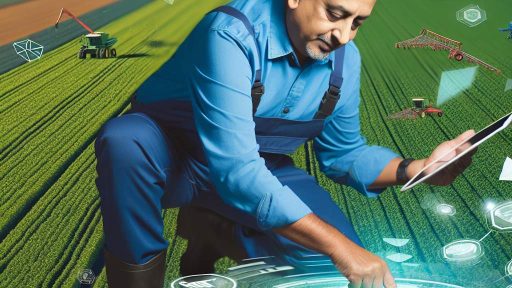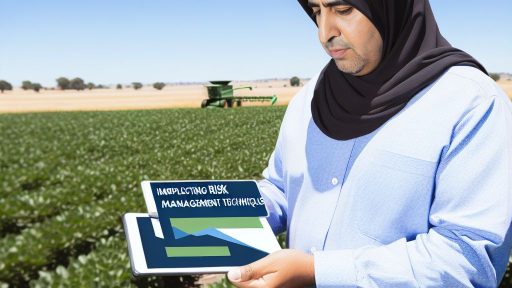Introduction to Crop Distribution and Supply Chain Management
Efficient crop distribution is vital for the agricultural sector.
It bridges the gap between producers and consumers effectively.
Supply chain management plays a crucial role in this process.
By optimizing every stage, farms can operate more effectively.
Understanding Supply Chain Dynamics
The supply chain consists of several interconnected steps.
These steps include production, processing, storage, and delivery.
Every link impacts overall efficiency and product quality.
The Role of Technology in Supply Chains
Technology enhances transparency in crop distribution.
For instance, real-time tracking systems can minimize delays.
Farmers, suppliers, and retailers can make quicker decisions.
Moreover, data analytics helps predict demand more accurately.
Challenges in Crop Distribution
Crop distribution faces various challenges in today’s market.
These challenges include logistical inefficiencies and climate factors.
Additionally, fluctuating consumer preferences can complicate distribution.
Addressing these challenges requires strategic planning and adaptability.
Transform Your Agribusiness
Unlock your farm's potential with expert advice tailored to your needs. Get actionable steps that drive real results.
Get StartedStrategies for Effective Management
Implementing advanced inventory management techniques is essential.
Such techniques ensure optimal stock levels throughout the year.
Regular training for personnel can improve supply chain responsiveness.
Furthermore, building strong relationships with suppliers can mitigate risks.
The Impact of Effective Supply Chain Management
Effective management can significantly enhance productivity.
It ensures that crops reach consumers in optimal condition.
Consequently, this leads to higher customer satisfaction and loyalty.
In the long run, it fosters a more sustainable farming industry.
Understanding the Current Challenges in Crop Distribution
Logistical Inefficiencies
Logistical challenges frequently hinder effective crop distribution.
Transportation delays can significantly impact freshness and quality.
Additionally, inadequate infrastructure complicates distribution routes.
These inefficiencies often lead to increased costs for producers.
Market Access Issues
Many farmers struggle to access lucrative markets.
Limited market connections reduce farmers’ negotiating power.
As a result, they may receive lower prices for their crops.
Consequently, this affects overall profitability and sustainability.
Variability in Crop Demand
Crops have fluctuating demand based on seasons and trends.
This variability makes it challenging to predict distribution needs.
Moreover, understanding consumer preferences requires constant research.
Failure to adapt can lead to overproduction or waste.
Environmental Factors
Adverse weather conditions can disrupt crop yields.
Extreme temperatures and natural disasters pose significant risks.
Moreover, climate change continues to exacerbate these challenges.
Farmers must adapt their distribution strategies accordingly.
Showcase Your Farming Business
Publish your professional farming services profile on our blog for a one-time fee of $200 and reach a dedicated audience of farmers and agribusiness owners.
Publish Your ProfileTechnology Integration Barriers
Many agricultural sectors lag in adopting technological solutions.
Technology can streamline logistics and enhance tracking.
However, costs and training can deter implementation.
Without technology, systems remain inefficient and outdated.
The Role of Technology in Streamlining Supply Chains for Agriculture
Enhancing Communication Across the Supply Chain
Effective communication is essential for a successful supply chain.
Technology provides tools that facilitate quicker communication.
For instance, mobile apps enable real-time updates between farmers and distributors.
Consequently, stakeholders can respond more swiftly to market changes.
This improved responsiveness leads to better decision-making.
Data Analytics for Informed Decisions
Data analytics allows firms to analyze vast amounts of information.
These insights help in predicting demand and optimizing inventory.
For example, predictive analytics can forecast crop yields based on historical data.
Thus, companies can allocate resources more efficiently.
This minimizes waste and maximizes profitability.
Supply Chain Visibility through Technology
Supply chain visibility is crucial for enhancing efficiency.
Track and trace technologies, such as RFID, provide detailed information about products.
They allow stakeholders to monitor produce from farm to consumer.
This transparency helps identify bottlenecks quickly.
As a result, businesses can reduce delays and improve service levels.
Streamlining Logistics with Automation
Automation plays a vital role in logistics management.
Using drones and automated vehicles optimizes delivery processes.
For instance, drones can quickly deliver produce to remote areas.
This technology saves time and reduces transportation costs.
Moreover, automation allows teams to focus on strategic tasks.
Integrating Blockchain for Security and Trust
Blockchain technology enhances security in the supply chain.
It ensures that all transactions are transparent and tamper-proof.
This level of security builds trust between consumers and producers.
For example, customers can verify the source of their food products.
This traceability promotes accountability in the agricultural sector.
Uncover the Details: Cost-Effective Pest Control Solutions For Farmers
Best Practices for Effective Supply Chain Management in Farming
Understanding the Supply Chain
Supply chain management is crucial for farming efficiency.
It connects farmers with suppliers and consumers effectively.
Understanding this system aids in improving crop distribution.
Utilizing Technology for Optimization
Integrating technology enhances supply chain processes.
For instance, farm management software streamlines operations.
This technology tracks inventory and demand trends efficiently.
Moreover, GPS systems optimize routes for delivery trucks.
Benefits of Data Analytics
Data analytics provides insights into crop performance.
It helps predict market demand accurately.
This approach minimizes waste and maximizes profits.
Showcase Your Farming Business
Publish your professional farming services profile on our blog for a one-time fee of $200 and reach a dedicated audience of farmers and agribusiness owners.
Publish Your ProfileBuilding Strong Relationships
Establishing solid relationships is vital in the supply chain.
Farmers should communicate regularly with suppliers.
This communication can ensure timely deliveries of resources.
Additionally, partnerships with local businesses can bolster sales.
Collaboration with Distributors
Effective collaboration with distributors increases efficiency.
It allows for better alignment of supply and demand.
Regular meetings can address challenges swiftly and effectively.
Implementing Sustainable Practices
Sustainable practices benefit the entire supply chain.
They reduce environmental impact and improve reputation.
Additionally, sustainability can decrease long-term costs.
Using Renewable Resources
Farmers should explore renewable resources for operations.
Solar energy can reduce reliance on non-renewable resources.
This transition not only saves money but also protects the environment.
Training and Development
Investing in training ensures everyone understands the supply chain.
Workshops can enhance skills and promote best practices.
Effective training leads to smoother daily operations.
Leveraging Expert Knowledge
Consulting with supply chain experts can add value.
These experts provide insights into industry best practices.
Their guidance helps navigate complex challenges successfully.
Uncover the Details: Leveraging Technology To Improve Crop Yields
Case Studies: Successful Implementation of Supply Chain Strategies
FarmLink Initiative
The FarmLink Initiative revolutionized crop distribution for small farmers.
By connecting producers directly with consumers, they reduce waste.
This approach has effectively cut transportation costs and improved profits.
FarmLink also uses data analytics to forecast demand accurately.
As a result, farmers plant crops that meet market needs.
AgriSupply Collaborations
AgriSupply formed strategic collaborations with logistics companies.
This partnership enhanced the efficiency of their supply chain processes.
They implemented real-time tracking for shipping, ensuring transparency.
This innovation improved delivery timelines and reduced spoilage rates.
AgriSupply’s commitment to technology transformed their operational capabilities.
HarvestPlus Strategy
HarvestPlus focuses on improving nutrition through biofortified crops.
Their supply chain management integrates production with local markets.
This strategy enhances the availability of nutritious food in underserved areas.
Through education and outreach, they empower farmers on best practices.
Consequently, these methods increase market access and crop sales.
Organic Valley’s Cooperative Model
Organic Valley operates as a farmer-owned cooperative.
This model allows for shared resources and collective bargaining.
They promote sustainable farming practices among their members.
The cooperative model minimizes risks and maximizes profits for farmers.
This success story highlights the power of collaboration in agriculture.
Showcase Your Farming Business
Publish your professional farming services profile on our blog for a one-time fee of $200 and reach a dedicated audience of farmers and agribusiness owners.
Publish Your ProfileSmartAg Innovations
SmartAg leverages technology to streamline the agricultural supply chain.
They utilize drones to monitor crop health and optimize resource usage.
These technological advancements lead to increased yields and efficiency.
By analyzing data, farmers can make informed decisions throughout the season.
SmartAg’s innovations showcase the future of crop management strategies.
Delve into the Subject: Leveraging Technology for Farm Supply Chain Optimization

The Importance of Collaboration Between Farmers and Distributors
Building Trust in Relationships
Collaboration begins with establishing trust between farmers and distributors.
Trust encourages open communication and transparency.
Both parties can discuss challenges and opportunities more freely.
Enhancing Efficiency Through Coordination
Effective supply chain management relies on coordinated efforts.
Farmers need timely information about market demands.
Distributors require knowledge of production schedules.
This synergy leads to optimized logistics.
Ultimately, it reduces waste and saves costs.
Leveraging Technology for Better Outcomes
Technology plays a crucial role in enhancing collaboration.
Data analytics can predict market trends accurately.
Moreover, digital platforms facilitate real-time updates.
Farmers can share harvest forecasts seamlessly.
Distributors can adjust their strategies accordingly.
Creating Joint Marketing Strategies
Collaborative marketing fosters brand unity and outreach.
Joint campaigns can increase visibility in the marketplace.
Farmers and distributors can leverage each other’s strengths.
Collective branding enhances consumer trust.
Joint efforts can lead to shared success.
Responding to Market Changes Together
Markets are dynamic, with frequent fluctuations.
Collaboration enables swift adjustments to strategy.
Farmers can respond to changes in distribution networks.
Conversely, distributors can adapt to supply disruptions.
This agility is key in maintaining competitiveness.
Learn More: Succession Planning For Long-Term Farm Financial Health And Growth
Impact of Climate Change on Crop Distribution
Changing Weather Patterns
Climate change significantly alters weather patterns worldwide.
Increased temperatures affect crop viability in various regions.
Extended droughts and intense rainfall disrupt growing seasons.
Farmers must adapt to these new challenges promptly.
Shifts in Crop Zones
As temperatures rise, traditional crop zones shift.
Crops previously grown in certain areas may become unsustainable.
Farmers face the necessity of exploring alternative crops.
This transition requires careful planning and preparation.
Impact on Yields
Unpredictable weather directly impacts crop yields.
Extreme weather events can reduce productivity dramatically.
Showcase Your Farming Business
Publish your professional farming services profile on our blog for a one-time fee of $200 and reach a dedicated audience of farmers and agribusiness owners.
Publish Your ProfileFarmers need improved practices to mitigate these effects.
Implementing these practices helps secure future harvests.
Supply Chain Solutions
Modern Technology Adoption
Farmers can embrace technology to enhance supply chain efficiency.
Tools like precision agriculture can optimize resource use.
Data analytics help forecast demand accurately.
Innovative solutions enhance communication across the supply chain.
Collaboration Among Stakeholders
Collaboration among farmers, suppliers, and distributors is essential.
Working together ensures a smoother transition during climate impacts.
Sharing data can lead to improved decision-making processes.
Effective partnerships strengthen the entire supply chain.
Investment in Infrastructure
Improved infrastructure supports more efficient crop distribution.
Investments in transportation networks are crucial for timely deliveries.
Efficient storage facilities minimize post-harvest losses.
This infrastructure directly impacts overall supply chain performance.
Future Trends in Crop Distribution and Supply Chain Innovations
Technological Advancements
Technology is transforming how we manage crop distribution.
Innovations like IoT devices enhance supply chain visibility.
Farmers can monitor crop conditions in real-time.
Additionally, drones streamline the monitoring process.
These technologies optimize transportation and logistics efficiently.
Sustainability Efforts
Sustainable practices are becoming integral to supply chains.
Consumers increasingly demand eco-friendly products.
Companies are adopting renewable energy sources for processes.
Local sourcing reduces transportation emissions significantly.
Furthermore, waste reduction initiatives improve overall sustainability.
Data Analytics Integration
Data analytics plays a crucial role in optimizing supply chains.
Companies use data to forecast demand accurately.
These insights facilitate smarter inventory management.
As a result, businesses can minimize stockouts efficiently.
Advanced analytics identifies potential bottlenecks proactively.
Collaboration Across the Supply Chain
Collaboration is essential for a resilient supply chain.
Farmers, suppliers, and retailers must work closely together.
This collaboration enhances communication and information sharing.
Joint ventures can lead to improved resource allocation.
Moreover, partnerships foster innovation and shared best practices.
Regulatory Changes and Compliance
Regulatory changes impact the agriculture and supply chain sector.
Companies must stay compliant with evolving food safety standards.
Changes in trade policies require businesses to adapt swiftly.
Furthermore, environmental regulations influence supply chain practices.
Staying informed ensures companies maintain compliance effectively.
Global Market Dynamics
Global market dynamics significantly influence crop distribution.
Showcase Your Farming Business
Publish your professional farming services profile on our blog for a one-time fee of $200 and reach a dedicated audience of farmers and agribusiness owners.
Publish Your ProfilePolitical factors can alter trade routes and export opportunities.
Developing economies present new market potential for crops.
Understanding these dynamics is vital for strategic planning.
Flexibility in operations enhances competitiveness globally.
Additional Resources
120-Day Food and Agriculture Interim Risk Review (March 2023)




